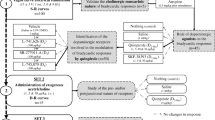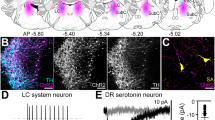Summary
The present electrophysiological studies examined the actions of neuroleptics at central α1adrenoceptors in the rat. In single-cell recording experiments, typical and atypical neuroleptics, when administered systemically or locally (iontophoresis and pressure ejection), were found to be potent antagonists of activating α1adrenoceptor responses in the dorsal lateral geniculate nucleus (dLGN). Doses of neuroleptics effective as antagonists at α1adrenoceptors had very weak effects as muscarinic receptors in the dLGN. Since doses of neuroleptics employed in the present study were within the clinical range, it appears likely that central α1adrenoceptors would be blocked during neuroleptic therapy in humans.
Similar content being viewed by others
References
Anden NE, Butcher GS, Corrodi H, Fuxe K, Ungerstedt U (1970) Receptor activity and turnover of dopamine and noradrenaline after neuroleptics. Eur J Pharmacol 11:303–314
Angst J, Bente D, Berner P, Heimann H, Helmchen H, Hippius H (1971) Das klinische Wirkungsbild von Clozapin. Pharmakopsychiatry 4:201–211
Bernheimer H, Birkmayer W, Hornykiewicz O, Jellinger K, Seitelberger F (1973) Brain dopamine and the syndromes of Parkinson and Huntington. J Neurol Sci 20:415–428
Blumberg JB, Vetulani J, Stawarz,RJ, Sulser F (1976) The noradrenergic cyclic AMP generating system in the limbic forebrain: Pharmacological characterization and possible role in the mode of action of antipsychotics. Eur J Pharmacol 37:357–366
Bradshaw CM, Pun RYK, Slater NT, Stooker MJ, Szabadi E (1980) Comparison of the effect of haloperidol on excitatory responses of cortical neurones to dopamine, noradrenaline and phenylephrine. Br J Pharmacol 71:243p-244p
Bunney BS, Aghajanian GK (1974) Antipsychotic drugs and central dopaminergic neurons: a model for predicting therapeutic efficacy and incidence of extrapyramidal side effects. In: Sudilovsky A, Gershon S, Beer B (eds) Predictiveness in psychopharmacology. Raven Press, New York
Bunney BS, Aghajanian GK (1975) The effect of antipsychotic drugs on the firing of dopaminergic neurons: A reappraisal. In: Sedvall G (ed) Antipsychotic drugs, pharmacodynamics and pharmacokinetics. Pergamon Press, New York, pp 305–318
Burki HR, Ruch W, Asper H (1975) Effects of clozapine, thioridazine, perlapine and haloperidol on the metabolism of the biogenic amines in the brain of the rat. Psychopharmacologica 41:27–33
Carlsson A, Lindqvist M (1963) Effect of chlorpromazine or haloperidol on formation of 3-methoxytyramine and normetanephrine in mouse brain. Acta Pharmacol et Toxicol 20:140–144
Clough DP, Hatton R (1981) Hypotensive and sedative effects of α-adrenoceptor agonists: relationship to α1- and α1adrenoceptor potency. Br J Pharmacol 73:595–604
DeJonge A, VanMeel JCA, Timmermans PBMWM, VanZwieten PA (1981) A lipophilic, selective α1adrenoceptor agonist: 2-(2-chloro-5-trifluoromethylphenylimino) imidazolidine (ST 587). Life Sci 28:2009–2016
Fuxe K (1975) Evidence for the existence of monoamine neurons in the central nervous system: I. V. The distribution of monoamine terminals in the central nervous system. Acta Physiol Scand 64: Suppl 247:39–85
Greenblatt EN, Coupet J, Rauch E, Szues-Myers VA (1980) IS dopamine antagonism a requisite of neuroleptic activity. Arch Int Pharmacodyn Ther 248:105–119
Greengrass P, Bremmer R (1979) Binding characteristics of3H-prazosin to rat brain α-adrenergic receptors. Eur J Pharmacol 55:323–326
Haigler HJ, Aghajanian GK (1974) Lysergic acid diethylamide and serotonin: a comparison of effects on serotonergic neurons and neurons receiving a serotonergic input. J Pharmacol Exp Ther 188:688–699
Huchet AM, Chelly J, Schmitt H (1981) Role of α1- and α1adrenoceptors in the modulation of the baroreflex vagal bradycardia. Eur J Pharmacol 71:455–461
Iversen LL (1975) Dopamine receptors in the brain. Science 188:1084–1089
Jenner P, Marsden CD (1979) The substituted benzamides: a novel class of dopamine antagonists. Life Sci 25:479–486
Jones BE, Moore RY (1977) Ascending projections of the locus coeruleus in the rat. II. Autoradiographic study. Brain Res 127:23–53
Kafka MS, VanKamen DP, Kleinman JE, Nürnberger JI, Siever LJ, Unde TW, Polinsky RJ (1980) Alpha-adrenergic receptor function in schizophrenia, affective disorders and some neurological diseases. Commun Psychopharmacol 4:477–486
Kessler KA, Waltezky JP (1981) Clinical use of the antipsychotics. Am J Psychiat 138:202–209
Kety SS, Matthysse S (1972) Prospects for research on schizophrenia; a report based on an NRP work session. Neurosci Res Prog Bull 10:370–507
Laduron P (1980) Dopamine receptor: from an in vivo concept towards a molecular characterization. Trends Pharmacol Sci Dec:471–474
Laduron PM, Leysen JE (1978) Is the low incidence of extrapyramidal side-effects of antipsychotics associated with antimuscarinic properties. J Pharm Pharmacol 30:120–122
Langer G, Sachar EJ, Gruen PH, Halpern FS (1977) Human prolactin responses to neuroleptic drugs correlate with antischizophrenic potency. Nature 266:639–640
Leysen JE, Niemeqeers CJE, Tollenaere JP, Laduron PM (1978) Serotonergic component of neuroleptic receptors. Nature 272:168–171
Nishiura M (1976) Clinico-pharmacological studies of sulpiride. Curr Ther Res 20:164–172
Peroutka SJ, U'Prichard DC, Greenberg DA, Snyder SH (1977) Neuroleptic drug interactions with norepinephrine alpha receptor binding sites in rat brain. Neuropharmacology 16:549–556
Peroutka SJ, Snyder SH (1980) Relationship of neuroleptic drug effects at brain dopamine, serotonin, α-adrenergic and histamine receptors to clinical potency. Am J Psychiat 137:1517–1522
Randrup A, Munkvad I (1972) Influence of amphetamine on animal behavior stereotypy functional impairment and possible animal human correlations. Psychiat Neurol Neurochem 75:193–292
Robinson SE, Sulser F (1976) The noradrenergic cyclic AMP generating system in the rat limbic forebrain and its stereospecificity for butaclamol. J Pharm Pharmacol 28:645–646
Robinson SE, Berney S, Mishra R, Sulser F (1979) The relative role of dopamine and norepinephrine receptor blockade in the action of antipsychotic drugs: metoclopramide, thiethylperazine and molindone as pharmacological tools. Psychopharmacology 64:141–147
Rogawski MA, Aghajanian GK (1980) Activation of lateral geniculate-neurons by norepinephrine: mediation by an α-adrenergic receptor. Brain Res 182:345–359
Snyder S, Greenberg D, Yamamura HI (1974) Antischizophrenic drugs and brain cholinergic receptors. Arch Gen Psychiat 31:58–61
Stille G, Lauener H, Eichenberger E (1971) The pharmacology of 8-chloro-11-(4-methyl-1-piperazinyl)-SH-dibenzo (6,C) (1,4) diazepine (clozapine). IC Farmaco 26:603–625
Stille G, Sayers AC, Lauener H, Eichenberger E (1973) 6-(4-methyl-1-piperazinyl)-morphanthridine (perlapine), a new tricyclic compound with sedative and sleep promoting properties. Psychopharmacologia (Berl) 28:325–337
Timmermans PBMWM, VanZwieten PA (1981) The postsynaptic α1adrenoceptor. J Auton Pharmacol 1:171–183
Wang RY, Aghajanian GK (1977) Inhibition of neurons in the amygdala by dorsal raphe stimulation: mediation through a direct serotonergic pathway. Brain Res 120:85–102
VanPraag HM, Korf J, Dols LCW (1976) Clozapine versus perphenazine the value of the biochemical mode of action of neuroleptics in predicting their therapeutic activity. Br J Psychiat 129:547–555
Author information
Authors and Affiliations
Rights and permissions
About this article
Cite this article
Marwaha, J., Aghajanian, G.K. Typical and atypical neuroleptics are potent antagonists at α1-adrenoceptors of the dorsal lateral geniculate nucleus. Naunyn-Schmiedeberg's Arch. Pharmacol. 321, 32–37 (1982). https://doi.org/10.1007/BF00586345
Received:
Accepted:
Issue Date:
DOI: https://doi.org/10.1007/BF00586345




